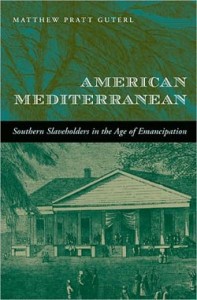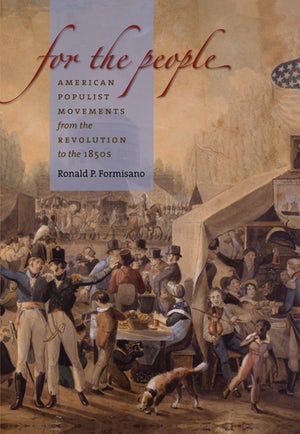Soon after the Civil War ended, several former members of the Confederacy’s political and military leadership found their way to Havana, Cuba, and “plotted their new lives” at the city’s Hotel Cubano (76). It was not the first time that the island had served as a refuge for white Southerners facing challenges posed by the “Age of Emancipation.” During the war, James and Eliza McHatton relocated their Louisiana sugar plantation to Cuba, so they could use a labor force of slaves and Chinese coolies. And before the conflict, many Southerners had seen the island as “a future state in the slave power bloc” (20). Several historians have incorporated the Caribbean and parts of Latin America into studies of the South in the Civil War era. But in American Mediterranean, Matthew Guterl makes a compelling argument that the connections among these lands were more numerous and significant than earlier scholars have suggested. The Southern elite, he argues, was “Internationally minded…and self-aware within a larger pan-American master class” (9) and thus saw themselves as part of a community of “New World slaveholders” (1).
Southern sectionalism, in other words, was international. Southern elites saw themselves not just as part of the United States and, later, the Confederacy but also as part of the “American Mediterranean”—the ring of lands that surround the Gulf of Mexico. Guterl adapts the term from Commander Matthew Maury, who in 1854 characterized the gulf as being to America what “the Mediterranean is to Europe, Africa, and Asia” (12). The relationship was not static. While some white Southerners asserted that the establishment of the Confederacy should unite them with Spain and Brazil in their wish to preserve slavery, the connection was likewise weakened by emancipation and weakened further still by passage of the Civil Rights Act in 1866. But the region’s relevance remained strong even as the relationship changed. During the war, the Confederacy received British supplies via Matamoras, Mexico. Some white Southerners suggested selling American slaves to Brazil to ensure that a race war would not follow emancipation. And in the Reconstruction era, Southern newspaper editors suggested that readers heed the problems faced by those who oversaw Jamaica’s freedmen, so as not to repeat their mistakes. Some of the plantation elite moved outside the United States to continue to keep slaves, but these exiles found that they could not replicate what they had lost. The high price of slaves in Brazil, for example, made them doubt that plantation agriculture could be profitable there, and some were put off by the extensive intermingling of the races, let alone the Brazilian idea that “money whitens” (85).
Meanwhile, the American Mediterranean had aspects that white Southerners regarded as foreboding. Planters tended to assume that all slave societies followed the same trajectory, which enhanced the importance of their developments. They reacted with alarm to news of British emancipation in the West Indies, Jamaica’s Morant Bay rebellion, and most of all Haiti’s rebellion and republic. Overseas accounts could influence policy. Some expected that American freedmen would be “idle” (117), since former West Indian slaves reportedly were, and this expectation informed their writing of the Black Codes passed after the Civil War.
Racism also challenged the unity of the American Mediterranean. Some Southern belles did marry Cuban natives, but many white Southerners believed in their superiority to the rest of the Americas and tried to avoid appearing “Latin.” Guterl’s work thus locates the South within the hemisphere’s slaveholding diaspora while also identifying it as a middle ground. It was, he maintains, “a messy, complicated borderland of sorts between North America and the Caribbean” (11). Part of this messiness owed to the fact that the traffic went both ways. Judah Benjamin, who held multiple posts in the Confederate government, had spent much of his childhood in the West Indies, and his father-in-law was a “Saint Domingue exile” (53). After the Haitian rebellion, many whites on the island sought refuge in Southern U.S. cities and brought slaves with them. And there were many Cuban expatriates in late-antebellum New Orleans.
At various points throughout the work, and especially in the epilogue, Guterl suggests that his subject fits not just within the historiography of slavery and the South, but also within the canon of business and labor history. He posits that Southern slaveholders, like modern businessmen, sought to relocate their operations outside the country in a quest for cheap labor and few regulations. And he connects the plight of coolies—who, though free, faced abuse and had little recourse if they were not paid—with that of many Latino immigrants who live in the Deep South today, legally and illegally.
This emphasis, most prominent in the epilogue, seems a bit abrupt, in part because earlier references appear infrequently and almost in an offhand fashion. Also, the large-scale relocation of factories and other operations outside the United States today seems far different from slaveholders’ efforts to move abroad, as those moves were the decisions of individual families, and their strategies frequently failed. (The high cost of slaves in Brazil would be a case in point.) In addition, Guterl, by describing the “cross-national cultural exchanges in the American Mediterranean” (6) is presenting a story that encompasses much more than moral debates and the bottom line. It is the exploration of how several groups of people from different lands interacted in an era of epic change. Yet the business comparison is provocative and can enhance understanding of both eras. Although people today condemn the nineteenth century’s slavery and overt racism, Guterl’s analogy suggests that it endures, in more muted forms, with regard to workers in today’s “global south.” And it reinforces the extent to which racism and financial concerns reinforced each other in nineteenth-century minds.
Guterl’s book is also a useful addition to the history of American foreign relations. Increasingly, scholars from several disciplines are approaching early America from a transnational perspective. Their studies demonstrate that significant, important connections existed, even in the absence of formal diplomacy, and that this broader approach is therefore necessary. They also can enhance more traditional diplomatic studies. Confederate Colonel John Thomas Pickett, for example, saw the Civil War as “emasculat[ing]” the Monroe Doctrine, because he and others saw benefits of European “meddling” in the New World (57).
Aside from one anachronistic reference to an antebellum West Virginia and a reference to James Monroe as the fourth president (he was fifth), American Mediterranean is error free. These minor quibbles aside, Guterl’s work is important, interesting, and well written.
Further Reading:
For additional reading on the international context of the Civil War-era South, see Demetrius L. Eudell, The Political Languages of Emancipation in the British Caribbean and the U.S. South (Chapel Hill, N.C., 2002); Amy Greenberg, Manifest Manhood and the Antebellum American Empire (Cambridge, 2005); Robert E. May, Manifest Destiny’s Underworld: Filibustering in Antebellum America (Chapel Hill, N.C., 2002); and Robert E. May, The Southern Dream of a Caribbean Empire, 1854-1861 (Athens, Ga., 1989).
This article originally appeared in issue 9.2 (January, 2009).
Elizabeth Kelly Gray is an assistant professor of history at Towson University. Her article “‘Whisper to him the word “India”‘: Trans-Atlantic Critics and American Slavery, 1830-1860” appeared in the Fall 2008 issue of the Journal of the Early Republic. She is currently writing a book-length study of opiate use in early America.



















